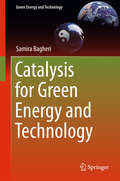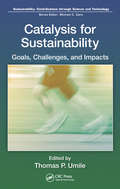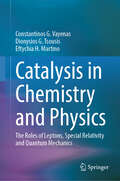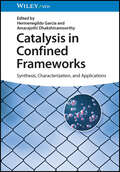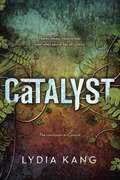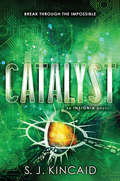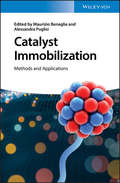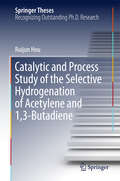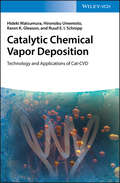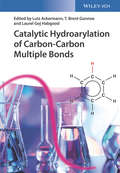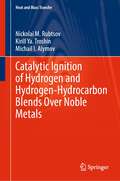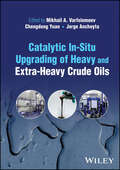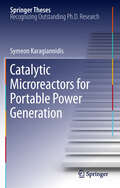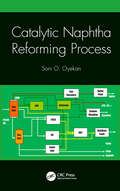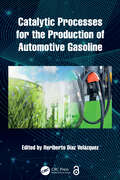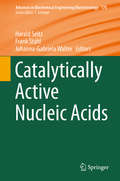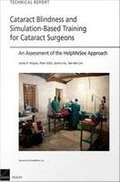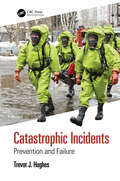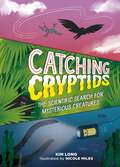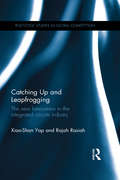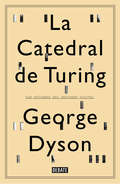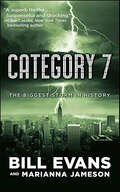- Table View
- List View
Catalysis for Clean Energy and Environmental Sustainability: Biomass Conversion and Green Chemistry - Volume 1
by K. K. Pant Sanjay Kumar Gupta Ejaz AhmadThis book is part of a two-volume work that offers a unique blend of information on realistic evaluations of catalyst-based synthesis processes using green chemistry principles and the environmental sustainability applications of such processes for biomass conversion, refining, and petrochemical production. The volumes provide a comprehensive resource of state-of-the-art technologies and green chemistry methodologies from researchers, academics, and chemical and manufacturing industrial scientists. The work will be of interest to professors, researchers, and practitioners in clean energy catalysis, green chemistry, chemical engineering and manufacturing, and environmental sustainability. This volume focuses on the potentials, recent advances, and future prospects of catalysis for biomass conversion and value-added chemicals production via green catalytic routes. Readers are presented with a mechanistic framework assessing the development of product selective catalytic processes for biomass and biomass-derived feedstock conversion. The book offers a unique combination of contributions from experts working on both lab-scale and industrial catalytic processes and provides insight into the use of various catalytic materials (e.g., mineral acids, heteropolyacid, metal catalysts, zeolites, metal oxides) for clean energy production and environmental sustainability.
Catalysis for Green Energy and Technology (Green Energy and Technology)
by Samira BagheriThis book describes the importance of catalysis for the sustainable production of biofuels and biochemicals, focusing primarily on the state-of-the-art catalysts and catalytic processes expected to play a decisive role in the "green" production of fuels and chemicals from biomass. The book also includes general sections exploring the entire chain of biomass production, conversion, environment, economy, and life-cycle assessment.
Catalysis for Sustainability: Goals, Challenges, and Impacts (ISSN)
by Thomas P. UmileCatalysis for Sustainability: Goals, Challenges, and Impacts explores the intersection between catalytic science and sustainable technologies as a means to addressing current economic, social, and environmental problems. These problems include harnessing alternative energy sources, pollution prevention and remediation, and the manufacturing of comm
Catalysis in Chemistry and Physics: The Roles of Leptons, Special Relativity and Quantum Mechanics
by Constantinos G. Vayenas Dionysios G. Tsousis Eftychia H. MartinoThis monograph explores the profound implications of neutrino discovery and their minuscule masses on our understanding of the Universe. It delves into the fundamental composition of matter, revealing that neutrinos, electrons, and positrons are the only indivisible particles. The book addresses the crucial question of hadronization: the process by which all other particles (hadrons, bosons, etc.) are formed from electrons, positrons, and neutrinos. It examines what catalyzes this significant transformation, which involves a substantial increase in mass. By integrating the Rotating Lepton Model (RLM) of hadrons and bosons with recent experimental data from CERN, the book demonstrates the essential role of electrons and positrons in facilitating the synthesis of hadrons and bosons from ambient neutrinos. It is a valuable resource for graduates, researchers, and academics working in the areas of physics, chemistry, and chemical engineering.
Catalysis in Confined Frameworks: Synthesis, Characterization, and Applications
by Hermenegildo GarciaCatalysis in Confined Frameworks Understanding the synthesis and applications of porous solid catalysts Heterogeneous catalysis is a catalytic process in which catalysts and reactants exist in different phases. Heterogeneous catalysis with solid catalysts proceeds through the absorption of substrates and reagents which are liquid or gas, and this is largely dependent on the accessible surface area of the solid which can generate active reaction sites. The synthesis of porous solids is an increasingly productive approach to generating solid catalysts with larger accessible surface area, allowing more efficient catalysis. Catalysis in Confined Frameworks: Synthesis, Characterization, and Applications provides a comprehensive overview of synthesis and use of porous solids as heterogeneous catalysts. It provides detailed analysis of pore engineering, a thorough characterization of the advantages and disadvantages of porous solids as heterogeneous catalysts, and an extensive discussion of applications. The result is a foundational introduction to a cutting-edge field. Catalysis in Confined Frameworks: Synthesis, Characterization, and Applications readers will also find: An editorial team comprised of international experts with extensive experience Detailed discussion of catalyst classes including zeolites, mesoporous aluminosilicates, and more A special focus on size selective catalysis Catalysis in Confined Frameworks: Synthesis, Characterization, and Applications is an essential reference for catalytic chemists, organic chemists, materials scientists, physical chemists, and any researchers or industry professionals working with heterogeneous catalysis.
Catalyst
by Lydia KangFor fans of Uglies and The Maze Runner comes a complex, thrill-filled love story that will make you question exactly what it means to be humanIn the past year Zel lost her father, the boy she loves, her safety, and any future she might have imagined for herself. Now she, her sister, and the band of genetic outcasts they've come to call their family are forced on the run when their safe house is attacked by men with neural guns. But on the way to a rumored haven in Chicago, Zel hears something--a whisper from Cy, the boy who traded himself for her sister's safety. And when she veers off plan in order to search for him, what she finds is not what she expected. There's more to their genetic mutations than they ever imagined...aspects that make them wonder if they might be accepted by the outside world after all.
Catalyst (The Insignia Novels #3)
by S. J. KincaidS. J. Kincaid has created a fascinating dystopian world for Insignia, her futuristic science-fiction adventure series perfect for fans of Ender's Game. Earth is in the middle of WWIII, battling to determine which governments and corporations will control the resources of the solar system.Teen Tom Raines grew up with nothing, some days without even a roof over his head. Then his exceptional gaming skills earned him a spot in the Intrasolar Forces, the country's elite military training program, and his life completely changed. Now, in Catalyst, the explosive series conclusion, dangerous changes have come to the Pentagonal Spire, where Tom and his friends train. When a mysterious figure starts fighting against the evil corporations' horrifying plans, but with methods Tom finds shocking, he must decide which side he's on.With slim odds of success, is it even worth the fight?
Catalyst Immobilization: Methods and Applications
by Maurizio BenagliaA comprehensive resource on techniques and applications for immobilizing catalysts Catalyst Immobilization: Methods and Applications covers catalyst immobilization topics including technologies, materials, characterization, chemical activity, and recyclability. The book also presents innovative applications for supported catalysts, such as flow chemistry and machine-assisted organic synthesis. Written by an international panel of expert contributors, this book outlines the general principles of catalyst immobilization and explores different types of supports employed in catalyst heterogenization. The book?s chapters examine the immobilization of chiral organocatalysts, reactions in flow reactors, 3D printed devices for catalytic systems, and more. Catalyst Immobilization offers a modern vision and a broad and critical view of this exciting field. This important book: -Offers a guide to supported and therefore recyclable catalysts, which is one of the most important tools for developing a highly sustainable chemistry -Presents various immobilization techniques and applications -Explores new trends, such as 3D printed devices for catalytic systems -Contains information from a leading international team of authors Written for catalytic chemists, organic chemists, process engineers, biochemists, surface chemists, materials scientists, analytical chemists, Catalyst Immobilization: Methods and Applications presents the latest developments and includes a review of the innovative trends such as flow chemistry, reactions in microreactors, and beyond.
Catalytic and Process Study of the Selective Hydrogenation of Acetylene and 1,3-Butadiene (Springer Theses)
by Ruijun HouThis thesis offers novel methods for catalyst and process design for the selective hydrogenation of acetylene and 1,3-butadiene. The author predicts the properties of supported Pd-Ni bimetallic catalysts using density functional theory (DFT) calculations and temperature-programmed desorption (TPD). The excellent correlation between model surfaces and supported catalysts demonstrates the feasibility of designing effective bimetallic catalysts for selective hydrogenation reactions. The author also proposes a method for designing non-precious metal catalysts to replace precious metals. He modifies the process of selective hydrogenation of acetylene by coupling the selective adsorption to the selective hydrogenation in the liquid phase, as a result of which the ethylene selectivity is greatly improved and heat transfer is greatly enhanced. Lastly, by analyzing the mechanism of liquid-phase hydrogenation, the author proposes a multi-stage slurry bed reactor for industrial applications.
Catalytic Chemical Vapor Deposition: Technology and Applications of Cat-CVD
by Karen K. Gleason Hideki Matsumura Hironobu Umemoto Ruud E.I. SchroppThe authoritative reference on catalytic chemical vapor deposition?written by the inventor of the technology This comprehensive book covers a wide scope of Cat-CVD and related technologies?from the fundamentals to the many applications, including the design of a Cat-CVD apparatus. Featuring contributions from four senior leaders in the field?including the father of catalytic chemical vapor deposition?it also introduces some of the techniques used in the observation of Cat-CVD related phenomena so that readers can understand the concepts of such techniques. Catalytic Chemical Vapor Deposition: Technology and Applications of Cat-CVD begins by reviewing the analytical tools for elucidating the chemical reactions in Cat-CVD, such as laser-induced fluorescence and deep ultra-violet absorption, and explains in detail the underlying physics and chemistry of the Cat-CVD technology. Subsequently it provides an overview of the synthesis and properties of Cat-CVD-prepared inorganic and organic thin films. The last parts of this unique book are devoted to the design and operation of Cat-CVD apparatuses and the applications. -Provides coherent coverage of the fundamentals and applications of catalytic chemical vapor deposition (Cat-CVD) -Assembles in one place the state of the art of this rapidly growing field, allowing new researchers to get an overview that is difficult to obtain solely from journal articles -Presents comparisons of different Cat-CVD methods which are usually not found in research papers -Bridges academic and industrial research?showing how CVD can be scaled up from the lab to large-scale industrial utilization in the high-tech industry Catalytic Chemical Vapor Deposition: Technology and Applications is an excellent one-stop resource for researchers and engineers working on or entering the field of Cat-CVD, Hot-Wire CVD, iCVD, and related technologies.
Catalytic Hydroarylation of Carbon-Carbon Multiple Bonds
by Lutz Ackermann T. Brent Gunnoe Laurel Goj HabgoodFilling a gap in the literature, this book comprehensively reviews catalytic C-H addition reactions of (hetero)aromatic hydrocarbons across carbon-carbon multiple bonds. In so doing, it summarizes both the scope as well as the limitations of different catalyst systems and building blocks, while highlighting their application to the synthesis of pharmaceuticals as well as commodity chemicals. Focusing on the latest developments, the team of authors comprising leaders in the field covers such topics as the hydroarylation of olefins, alkyne hydroarylation in the presence of transition metal catalysts, reaction of alkynes with arylboronic acids, and allene hydroarylation, as well as the synthesis of functionalized arenes and heteroaromatics. A must-have for synthetic chemists in academia and industry dealing with catalysis, organometallic chemistry, the synthesis of natural products, fine chemicals, pharmaceuticals, products of the chemical industry and organic materials.
Catalytic Ignition of Hydrogen and Hydrogen-Hydrocarbon Blends Over Noble Metals (Heat and Mass Transfer)
by Nickolai M. Rubtsov Kirill Ya. Troshin Michail I. AlymovThis book examines the issues on noble metal influence on gaseous combustion. The book focuses on the new data on combustion processes having practical applications and includes fire safety issues in the use of noble metals in hydrogen recombiners for NPP, as well as in catalytically stabilized (CS) combustion technology including stimulation of combustion of hydrogen-blended hydrocarbons, synthesis of carbon nanotubes, and determination of catalytic ignition limits in noble metal-hydrogen-hydrocarbon systems to meet the challenges of explosion safety.
Catalytic In-Situ Upgrading of Heavy and Extra-Heavy Crude Oils
by Mikhail A. Varfolomeev Chengdong Yuan Jorge AncheytaCatalytic In-Situ Upgrading of Heavy and Extra-Heavy Crude Oils A comprehensive guide to a cutting-edge and cost-effective refinement process for heavy oil Oil sufficiently viscous that it cannot flow normally from production wells is called heavy oil and constitutes as much as 70% of global oil reserves. Extracting and refining this oil can pose significant challenges, including very high transportation costs. As a result, processes which produce and partially refine heavy oil in situ, known as catalytic upgrading, are an increasingly important part of the heavy oil extraction process, and the reduced carbon footprint associated with these methods promises to make them even more significant in the coming years. Catalytic In-Situ Upgrading of Heavy and Extra-Heavy Crude Oils provides a comprehensive introduction to these processes. It introduces the properties and characteristics of heavy and extra-heavy oil before discussing different catalysts and catalyzing processes, their mechanisms and underlying physics, and more. It offers the full sweep of description and analysis required for petroleum and chemical engineers to understand this vital aspect of the modern oil industry. Readers will also find: Detailed discussion of subjects including electron paramagnetic resonance spectroscopy, nuclear magnetic resonance spectroscopy, and more Analysis of both liquid catalysts and nanoparticle catalysts A numerical simulation of the catalytic in-situ oil upgrading process Catalytic In-Situ Upgrading of Heavy and Extra-Heavy Crude Oils is a valuable reference for petroleum and chemical engineers as well as advanced undergraduate and graduate students in related fields.
Catalytic Microreactors for Portable Power Generation (Springer Theses)
by Symeon Karagiannidis"Catalytic Microreactors for Portable Power Generation" addresses a problem of high relevance and increased complexity in energy technology. This thesis outlines an investigation into catalytic and gas-phase combustion characteristics in channel-flow, platinum-coated microreactors. The emphasis of the study is on microreactor/microturbine concepts for portable power generation and the fuels of interest are methane and propane. The author carefully describes numerical and experimental techniques, providing a new insight into the complex interactions between chemical kinetics and molecular transport processes, as well as giving the first detailed report of hetero-/homogeneous chemical reaction mechanisms for catalytic propane combustion. The outcome of this work will be widely applied to the industrial design of micro- and mesoscale combustors.
Catalytic Naphtha Reforming Process
by Soni O OyekanBased on the author’s decades of years of experience in oil refining, Catalytic Naphtha Reforming Process conveys essential information on key concepts, operations, and practices of catalytic naphtha reforming technologies and associated oil refining processes. The book reviews collective technical and operational advancements with respect to efficient use of catalysts and catalytic reformers in oil refining and incorporates key advancements from recent developments in catalytic reforming technologies and processes. High octane reformate gasoline blendstock production via the use of high performing continuous catalyst regenerative processes is emphasized for regulated, environmentally friendly gasoline. The benefits of timely, effective process unit monitoring are covered in this book. Some of the principal objectives of this book include the need to emphasize more proactive approaches in the planning, operations and maintenance of catalytic reforming units and oil refineries. A number of recommendations are provided for enhancing the operations, reliability, and productivity of catalytic reformers and oil refineries.
Catalytic Processes for the Production of Automotive Gasoline
by Heriberto Díaz VelázquezThis book serves as the most comprehensive and advanced resource available on catalytic processes to produce automotive gasoline. It discusses enhancers and emerging technologies such as the obtention of gasoline from biomass, gasoline from carbon dioxide, and synthetic gasoline: MTG and Fischer–Tropsch. It concludes with a general outlook on the future of gasoline production and discussion of electric vehicles.A valuable reference for researchers and advanced students, this text also provides a strong basis for professional engineers, scientists, and entrepreneurs in the oil, gas, and energy industry.In general, this book: Explains all aspects of gasoline production, including principles and recent developments Discusses the use of GHGs such as CO2 to produce gasoline/fuels Discusses on the different additives to enhance the gasoline performance and stability Covers oil- and non-oil-based catalytic processes Contrasts the new electromobility technologies and contemplates the future of gasoline use trends
Catalytically Active Nucleic Acids (Advances in Biochemical Engineering/Biotechnology #170)
by Harald Seitz Frank Stahl Johanna-Gabriela WalterThis volume reviews numerous reaction mechanisms and applications of nucleic acids with catalytic activity. Written by an interdisciplinary team of authors, it provides an essential overview of these acids’ fundamental aspects, while also addressing associated methodologies such as nucleic acid enzyme engineering, peroxidase-mimicking DNAzymes and Aptazymes. After the discovery of natural ribozymes – RNA molecules that mediate the cleavage and formation of phosphodiester bonds and the formation of peptide bonds – numerous artificial ribozymes with altered catalytic activities were produced by in vitro and in vivo selection. Unlike ribozymes, DNAzymes do not occur in nature. Although the catalytic activity of nucleic acid enzymes is usually much slower than that of proteins, nucleic acid enzymes with comparable catalytic activity have been obtained using stringent selection processes. The key advantages of these enzymes: they are e.g. smaller, easier to produce and purify than proteins, and can withstand denaturation, e.g. by heat. Over the last few years, the number of publications on the applications of enzymatic nucleic acids has grown steadily. Summarizing the fundamentals and applications of these acids, this book will not only be an excellent resource for experts in the field but will also guide young researchers just starting out in this significant area.
Cataract Blindness and Simulation-Based Training for Cataract Surgeons: An Assessment of the HelpMeSee Approach
by James R. Broyles Peter Glick Jianhui Hu Yee-Wei LimCataracts cause about half of all cases of blindness worldwide, largely in developing countries. HelpMeSee Inc. is developing a simulator-based method for rapid cataract surgical training that RAND researchers determined could significantly help to close the backlog of cataract cases, expected to be 32 million globally by 2020. For this to occur, challenges in the areas of outreach, quality monitoring, and public acceptance must be met.
Catastrophic Incidents: Prevention and Failure
by Trevor J. HughesThis interesting book offers an analysis of man-made catastrophes and asks why they continue to occur. 87 catastrophes or near-catastrophes, including high profile cases such as the Bhopal gas disaster, Grenfell Tower, Shoreham Air Show crash, Brumadinho dam collapse and Fukushima Daiichi, are described together with the reasons why they occurred and why over 50 different safety management approaches and techniques failed to prevent them. Featuring 63 eye opening stories from the author’s own personal experience and over 200 pitfalls in safety management approaches, this title is illustrated by 24 hypothetical cases in which the reader is asked to consider the approach they would take. Safety management techniques discussed include operating practices, personnel selection and emergency response. Safety management approaches including safety governance in organisations, along with the role of government and local authorities using the instruments of the law are extensively discussed. The work concludes with imaginative and creative ways forward with the aim to make considerable progress and to potentially eliminate man-made catastrophes for good. This title will be an ideal read for safety managers and engineers, community leaders in civic duties or labour union roles and professionals tasked with stopping and mitigating the impacts of man-made catastrophes, along with non-technical readers who are curious and concerned.
Catching a Hacker (Arkansas Special Agents: Cyber Crime Division)
by Maggie WellsThe danger is closing inAnd she&’ll risk her life and heart to help him protect his daughter Arkansas Special Agent Emma Parker is determined to uncover a cyberbully targeting local teens—and Max Hughes&’s daughter, Kayleigh, is the prime suspect. Max gives Emma full access to their home and technology to clear Kayleigh&’s name, never counting on his attraction to the driven cop…nor their sinister discovery. Because someone has turned Kayleigh&’s computer against her. Watching her. Stealing her data. And worse, using that information to get at other students…From Harlequin Intrigue: Seek thrills. Solve crimes. Justice served.Discover more action-packed stories in the Arkansas Special Agents: Cyber Crime Division series. All books are stand-alone with uplifting endings but were published in the following order: Book 1: Shadowing Her StalkerBook 2: Catching a HackerBook 3: Ozarks Conspiracy
Catching Cryptids: The Scientific Search for Mysterious Creatures
by Kim LongLearn how to find Kraken, Mothman, Microbats, and more in this fun, fact-filled, STEM-based cryptozoology book for fans of The Book of Mythical Beasts and Magical Creatures. For years the kraken was considered a mythical beast. Then, in 2004, high-tech cameras captured a photo of a living giant squid. Advances in technology have provided scientists with new tools to study previously undiscovered/unresearched habitats: high-tech cameras, forensic analysis, underwater robots, bioacoustics, infrared sensors, drones, remote control photography and measurement tools, airborne DNA, footprint identification, and more. Catching Cryptids explores these technological advances in a fun way by pairing them with mythical creatures and discussing how modern technology could be used to locate or &“catch&” these beasts. The book includes a mini history of each cryptid, along with interesting facts about the corresponding field of science, and spot illustrations throughout. Featuring over 45 creatures found on land, in water, and among the skies, Catching Cryptids will leave readers wondering what&’s next? The phoenix? Dragons? The possibilities are endless! A Junior Library Guild (JLG) Gold Standard Selection!
Catching Fire: The Story of Firefighting
by Gena K. GorrellAn entertaining and informative look at firefighting, from the equipment to the techniques, both in history and today. Anecdotes from firefighters, and fire prevention and safety tips.
Catching Up and Leapfrogging: The new latecomers in the integrated circuits industry (Routledge Studies in Global Competition)
by Xiao-Shan Yap Rajah RasiahEver since Schumpeter’s groundbreaking work there has been a plethora of new research seeking to extend the direction and dynamics of innovation. Using a rich account of detailed interviews, this book offers new evidence on how latecomers have successfully caught up and leapfrogged incumbent firms. Catching Up and Leapfrogging: the new latecomers in the integrated circuits industry explores how technological transitions affect latecomer catch-up strategies, and vice versa, in a high technology industry. It looks to the East Asian latecomers who, towards the end of the twentieth century, pioneered a new pathway through organizational change by specializing in the key production stages of integrated circuits and pushing technologies further. This volume assesses how latecomer resource acquisition strategies have varied alongside structural industry changes and evaluates the mechanisms through which firms started life as technology followers and rose to become technology leaders. Xiao-Shan Yap and Rajah Rasiah present a unique story about how firm strategies evolve from the catching up phase to the leapfrogging phase, captured from the accounts of managers on the ground. It is the first time firm-level strategies have been systematically analysed to describe twenty-first century strategic management in the integrated circuits industry in particular, and the high tech industry in general. The evidence and analysis in this book offers insights for chief executive officers, policy-makers and researchers to revisit existing approaches to the theory of catching up and leapfrogging.
La catedral de Turing: Los orígenes del universo digital
by George Dyson«Es posible inventar una sola máquina que pueda utilizarse para computar cualquier secuencia computable», anunció en 1936 un joven Alan Turing de veinticuatro años. En los años 40 y 50 un reducido grupo de hombres y mujeres, liderado por John von Neumann, se reunió en Princeton, New Jersey, para comenzar la construcción de una de los primeros ordenadores que materializaría la visión de Alan Turing de una máquina universal. Los códigos generados en ese embrión de universo de 5 kilobytes (menos memoria de lo que requiere un solo icono en la pantalla de un ordenador actual) rompieron la distinción entre números que significan cosas y números que hacen cosas, y nuestro universo cambió para siempre. La catedral de Turing es la historia de la invención más constructiva del siglo XX, el ordenador digital, de quiénes y cómo la crearon. Un relato histórico y profético que nos cuenta cómo el código logró conquistar el mundo y se aventura a plantear el futurodel universo digital."No es solo un libro extraordinario sobre ciencia. Es un libro extraordinario, punto." #The Globe and Mail «Si quieres estar mentalmente preparado para la próxima revolución informática, el libro de Dyson es imprescindible. Pero también es imprescindible si solo quieres una historia apasionada de cómo los científicos de verdad (como mínimo algunos) piensan y trabajan.» Literary Review
Category 7
by Bill Evans Marianna JamesonA Category 4 hurricane, with winds of up to 155 miles per hour, tears roofs off buildings, smashes windows and doors, and can send floodwaters up to the second floor. Evacuation is suggested for up to six miles inland. Hurricane Katrina was a Category 4 when she made landfall. Hurricane Simone is a Category 7—the biggest, strongest storm in recorded history. When she hits New York City, skyscrapers will fall. Subways and tunnels will flood. Lower Manhattan and much of Queens and Brooklyn will disappear under more than thirty feet of water. All along the Eastern Seaboard, towns and cities are being evacuated as wind-driven rain lashes the coast and storm surges crash through seawalls. Roads are packed with fleeing motorists whose cars are jammed with every personal possession that can be crammed in, plus family members, friends, and beloved pets. A huge natural disaster is brewing in the Atlantic.Except that Simone isn't natural. She's the product of rogue weather science being wielded by billionaire Carter Thompson as part of a personal vendetta against US President Winslow Benson. Once Carter wanted to bring rain to the desert and feed the starving peoples of the planet. Now he wants to show Benson—and the rest of the world—just how powerful wind and water can be.If technology created Simone, perhaps technology can stop her. It's up to Kate Sherman, once a member of Carter's weather team; and Jake Baxter, a weatherman for the CIA, to try, using a secret US Navy weapon. The catch? It has to be deployed inside the hurricane. At the Publisher's request, this title is being sold without Digital Rights Management Software (DRM) applied.

